| ID |
Date |
Author |
Topic |
Subject |
|
121
|
28 Oct 2003 |
Stefan Ritt | | Updated thread functions |
> ss_thread_create now returns the thread ID on success, and zero on failure.
> Previously returned SS_SUCCESS or SS_NO_THREAD. User must now test the
> return value to determine result.
>
> ss_thread_kill added to kill the passed thread ID. Returns SS_SUCCESS or
> SS_NO_THREAD.
>
> Any thread creation must be verified now, and old code must be examined to
> ensure the return value is checked.
Thank you for that post. Internally, threads are not use in midas, so there
should be no problem. Only experiments using threads explicitly should take
care. |
|
638
|
06 Sep 2009 |
Exaos Lee | Suggestion | Updated "CMakeLists.txt" |
Add installation commands. Please see the attachment. |
| Attachment 1: CMakeLists.txt
|
#-*- mode: cmake -*-
## CMake pre-settings
cmake_minimum_required(VERSION 2.6)
cmake_policy(VERSION 2.6)
cmake_policy(SET CMP0011 NEW)
set(CMAKE_MODULE_PATH ${CMAKE_MODULE_PATH} "${CMAKE_SOURCE_DIR}/cmake/")
## Project setup
project(MIDAS)
set(EXECUTABLE_OUTPUT_PATH ${PROJECT_BINARY_DIR}/bin)
set(LIBRARY_OUTPUT_PATH ${PROJECT_BINARY_DIR}/lib)
enable_language(C)
enable_language(CXX)
## Include utilities and options
# Find mxml
include(FindMXML)
include_directories(include ${MXML_PATH})
# OS specific flags
# OS-related CMake variables:
# 1. OS_EXTRA_UTILS --- Extra utilities for specific OS
# 2. OS_EXTRA_LDFLAGS --- Extra link flags for specific OS
# 3. OS_EXTRA_DEFS --- Extra definitions for specific OS
# 4. Other flags switched on for specific OS
include(OSflags)
include(FindROOT) # Find ROOT environment
include(FindMySQL) # Find MySQL
include(FindODBC) # Find ODBC
include(FindZLIB) # Find zlib
## Options for MIDAS
set(NEED_CERNLIB TRUE) # Need CERNLIB or not?
set(NEED_SHLIB TRUE) # Need shared library?
set(NEED_ROOT TRUE) # Need root?
set(NEED_FTPLIB TRUE) # Need ftp protocol?
#set(NEED_STRLCPY TRUE) # Need strlcpy.h? -- maybe opened in OSflags.cmake
#set(MIDAS_MAX_EVENT_SIZE 1000000) # maxmimum event size = ?
##############################################################################
## Setup options
## OS-specific
add_definitions(${OS_EXTRA_DEFS})
set(LDFLAGS "${LDFLAGS} ${OS_EXTRA_LDFLAGS}")
set(EXTRA_UTILS ${EXTRA_UTILS} ${OS_EXTRA_UTILS})
## Midas max event size
if(MIDAS_MAX_EVENT_SIZE)
add_definitions(-DMAX_EVENT_SIZE=${MIDAS_MAX_EVENT_SIZE})
endif(MIDAS_MAX_EVENT_SIZE)
## strlcpy in "MXML"?
if(NEED_STRLCPY)
set(EXTRA_OBJS ${EXTRA_OBJS} strlcpy)
add_definitions( -DHAVE_STRLCPY )
message(STATUS "Using Stephen's own strlcpy()")
endif(NEED_STRLCPY)
## FTPLIB needed?
if(NEED_FTPLIB)
set(FTPLIB ftplib)
add_definitions(-DINCLUDE_FTPLIB)
message(STATUS "Using ftplib (FTP library)")
endif(NEED_FTPLIB)
## ODBC: -lodbc or -liodbc
if(ODBC_FOUND)
message(STATUS "Add ODBC-specified targets using ${ODBC_LIBRARY}")
set(EXTRA_UTILS ${EXTRA_UTILS} mh2sql)
add_definitions(-DHAVE_ODBC)
set(LDFLAGS "${LDFLAGS} -l${ODBC_NAME}")
else(ODBC_FOUND)
message(STATUS "ODBC not found!")
endif(ODBC_FOUND)
## ZLIB
if(ZLIB_FOUND)
add_definitions(-DHAVE_ZLIB)
set(LDFLAGS "${LDFLAGS} -lz")
endif(ZLIB_FOUND)
## ROOT
if(NEED_ROOT AND ROOT_FOUND)
message(STATUS "Using ROOT at ${ROOTSYS}")
if(NEED_RPATH) # Add rpath ..
set(ROOT_LIBS "${ROOT_LIBS} -Wl,-rpath,${ROOTSYS}/lib")
endif(NEED_RPATH)
## libRoot.a: Static ROOT library
if(NEED_LIBROOTA AND ROOT_LIBA)
set(LDFLAGS "${LDFLAGS} ${ROOTSYS}/lib/libRoot.a -lssl -ldl -lcrypt")
message(STATUS "Using statlic ROOT library: ${ROOT_LIBA}")
endif(NEED_LIBROOTA AND ROOT_LIBA)
endif(NEED_ROOT AND ROOT_FOUND)
####### MIDAS library and objects #########################
## Objects needed to build the libmidas(.a,.so,..)
foreach(obj ${FTPLIB} midas system mrpc odb ybos history alarm elog)
set(LIB_OBJS ${LIB_OBJS} src/${obj}.c)
endforeach(obj)
foreach(obj mxml ${EXTRA_OBJS})
set(LIB_OBJS ${LIB_OBJS} ${MXML_PATH}/${obj}.c)
endforeach(obj)
if(ODBC_FOUND)
set(LIB_OBJS ${LIB_OBJS} src/history_odbc.cxx)
endif(ODBC_FOUND)
## Library definition
## Add static lib
add_library(midas-static STATIC ${LIB_OBJS})
set_target_properties(midas-static PROPERTIES OUTPUT_NAME "midas")
if(NEED_SHLIB) # Add shared lib
add_library(midas-shared SHARED ${LIB_OBJS})
set_target_properties(midas-shared PROPERTIES OUTPUT_NAME "midas")
endif(NEED_SHLIB)
########## Utilities ######################################
## Core Utilties
set(CORE_UTILS mserver mhttpd mlogger odbedit lazylogger)
add_executable(mserver src/mserver.c)
add_executable(mlogger src/mlogger.c)
add_executable(mhttpd src/mhttpd.c src/mgd.c )
add_executable(odbedit src/odbedit.c src/cmdedit.c )
add_executable(lazylogger src/lazylogger.c)
foreach(exe ${CORE_UTILS})
target_link_libraries(${exe} midas-static)
set_target_properties(${exe} PROPERTIES LINK_FLAGS "${LDFLAGS}")
endforeach(exe)
set_target_properties( mhttpd PROPERTIES
LINK_FLAGS "-lm ${LDFLAGS}" LINKER_LANGUAGE CXX )
## for mlogger --- It's BAD to name a CXX source using ".c" file extension !!!
set_target_properties( mlogger
PROPERTIES
LINK_FLAGS "${MYSQL_LIBS} ${ROOT_LIBS} ${LDFLAGS}"
LINKER_LANGUAGE CXX
COMPILE_FLAGS "${ROOT_CFLAGS}" )
set_source_files_properties( src/mlogger.c PROPERTIES LANGUAGE CXX )
## Utilities
set(UTILS mtape mhist mstat mdump mchart
webpaw odbhist melog mcnaf
mhdump mtransition # C++ codes
${EXTRA_UTILS} )
foreach(exe mtape mhist mstat mdump melog mchart odbhist webpaw)
add_executable(${exe} utils/${exe}.c)
endforeach(exe)
add_executable(mhdump utils/mhdump.cxx)
add_executable(mcnaf utils/mcnaf.c drivers/camac/camacrpc.c)
add_executable(mtransition src/mtransition.cxx)
# optional utilities
if("${UTILS}" MATCHES "mh2sql")
add_executable(mh2sql utils/mh2sql.cxx src/history_odbc.cxx )
endif("${UTILS}" MATCHES "mh2sql")
if("${UTILS}" MATCHES "mlxspeaker")
add_executable(mlxspeaker utils/mlxspeaker.c)
endif("${UTILS}" MATCHES "mlxspeaker")
if("${UTILS}" MATCHES "dio")
add_executable(dio utils/dio.c)
endif("${UTILS}" MATCHES "dio")
foreach(exe ${UTILS})
add_dependencies(${exe} midas-static)
target_link_libraries(${exe} midas-static)
set_target_properties(${exe} PROPERTIES LINK_FLAGS "${LDFLAGS}")
endforeach(exe)
## Scripts
set(SCRIPTS stripchart.tcl ) # TCL script
## Special targets
## for generating mfe.o
add_custom_command( OUTPUT mfe.o DEPENDS src/mfe.c
COMMAND ${CMAKE_C_COMPILER}
ARGS -I${CMAKE_SOURCE_DIR}/include -c ${CMAKE_SOURCE_DIR}/src/mfe.c
WORKING_DIRECTORY lib )
add_custom_target(mfe ALL DEPENDS mfe.o)
## for generating mfe.o
add_custom_command( OUTPUT fal.o DEPENDS src/fal.c
COMMAND ${CMAKE_C_COMPILER}
ARGS -I${CMAKE_SOURCE_DIR}/include -Dextname -DMANA_LITE
-c ${CMAKE_SOURCE_DIR}/src/fal.c
WORKING_DIRECTORY lib )
add_custom_target(fal ALL DEPENDS fal.o)
## analyzer objects: mana.o
add_custom_command( OUTPUT mana.o DEPENDS src/mana.c
COMMAND ${CMAKE_C_COMPILER}
ARGS -I${CMAKE_SOURCE_DIR}/include -c ${CMAKE_SOURCE_DIR}/src/mana.c
WORKING_DIRECTORY lib )
add_custom_target(mana ALL DEPENDS mana.o)
set(EXTRA_MOBJS mfe.o fal.o mana.o)
# rmana.o
if(NEED_ROOT)
set(ARG_LIST "-DUSE_ROOT ${ROOT_CFLAGS} -I${CMAKE_SOURCE_DIR}/include -o rmana.o -c ${CMAKE_SOURCE_DIR}/src/mana.c")
separate_arguments(ARG_LIST)
add_custom_command( OUTPUT rmana.o DEPENDS src/mana.c
COMMAND ${CMAKE_CXX_COMPILER}
ARGS ${ARG_LIST} WORKING_DIRECTORY lib )
add_custom_target(rmana ALL DEPENDS rmana.o )
set(EXTRA_MOBJS ${EXTRA_MOBJS} rmana.o )
endif(NEED_ROOT)
## hmana.o
if(NEED_CERNLIB)
add_custom_command( OUTPUT hmana.o DEPENDS src/mana.c
COMMAND ${CMAKE_C_COMPILER}
ARGS -I${CMAKE_SOURCE_DIR}/include -Dextname -DHAVE_HBOOK -o hmana.o
-c ${CMAKE_SOURCE_DIR}/src/mana.c
WORKING_DIRECTORY lib )
add_custom_target(hmana ALL DEPENDS hmana.o)
set(EXTRA_MOBJS ${EXTRA_MOBJS} hmana.o )
endif(NEED_CERNLIB)
########## Drivers and modules ################################
#
########## Examples ###########################################
#
########## Installation########################################
#
## Library and objects (custom targets)
install(TARGETS midas-static ARCHIVE DESTINATION lib)
if(NEED_SHLIB)
install(TARGETS midas-shared LIBRARY DESTINATION lib
PERMISSIONS OWNER_READ OWNER_WRITE OWNER_EXECUTE
GROUP_READ GROUP_EXECUTE WORLD_EXECUTE WORLD_READ)
endif(NEED_SHLIB)
foreach(obj ${EXTRA_MOBJS})
install(FILES ${PROJECT_BINARY_DIR}/lib/${obj} DESTINATION lib)
endforeach(obj)
## Core and extra utilities, scripts
install(TARGETS ${CORE_UTILS} ${UTILS}
RUNTIME DESTINATION bin
PERMISSIONS OWNER_READ OWNER_WRITE OWNER_EXECUTE
GROUP_READ GROUP_EXECUTE WORLD_EXECUTE WORLD_READ)
#install ${SCRIPTS}
foreach(script ${SCRIPTS})
install(FILES utils/${script} DESTINATION bin
PERMISSIONS OWNER_READ OWNER_WRITE OWNER_EXECUTE
GROUP_READ GROUP_EXECUTE WORLD_EXECUTE WORLD_READ)
endforeach(script)
## include, src, examples, drivers
# install(DIRECTORY include/ DESTINATION include/midas
# FILES_MATCHING PATTERN "*.h")
# install(DIRECTORY src DESTINATION share/midas)
# install(DIRECTORY examples DESTINATION share/midas)
# install(DIRECTORY drivers DESTINATION share/midas)
install(DIRECTORY include/ DESTINATION include
FILES_MATCHING PATTERN "*.h")
install(DIRECTORY src/ DESTINATION src)
install(DIRECTORY examples/ DESTINATION examples)
install(DIRECTORY drivers/ DESTINATION drivers)
|
|
252
|
07 May 2006 |
Konstantin Olchanski | Bug Fix | Update & add VME drivers |
I commited fixes for a few minor compilation errors in the VME drivers
(vmicvme.c, etc)
I also added new drivers for the v513 latch and v560 scaler that I wrote for
CERN-ALPHA.
(Maybe I should mention that we also have drivers for the SIS 3820 multiscaler,
the v895 VME discriminator and a few more modules. Will commit them as they mature).
K.O. |
|
2298
|
29 Oct 2021 |
Kushal Kapoor | Bug Report | Unknown Error 319 from client |
I’m trying to run MIDAS using a frontend code/client named “fetiglab”. Run stops
after 2/3sec with an error saying “Unknown error 319 from client “fetiglab” on
localhost.
Frontend code compiled without any errors and MIDAS reads the frontend
successfully, this only comes when I start the new run on MIDAS, here are a few
more details from the terminal-
11:46:32 [fetiglab,ERROR] [odb.cxx:11268:db_get_record,ERROR] struct size
mismatch for "/" (expected size: 1, size in ODB: 41920)
11:46:32 [Logger,INFO] Deleting previous file
"/home/rcmp/online3/run00621_000.root"
11:46:32 [ODBEdit,ERROR] [midas.cxx:5073:cm_transition,ERROR] transition START
aborted: client "fetiglab" returned status 319
11:46:32 [ODBEdit,ERROR] [midas.cxx:5246:cm_transition,ERROR] Could not start a
run: cm_transition() status 319, message 'Unknown error 319 from client
'fetiglab' on host "localhost"'
TR_STARTABORT transition: cleanup after failure to start a run
‌
I’ve also enclosed a screenshot for the same, any suggestions would be highly
appreciated. thanks |
| Attachment 1: Screenshot_2021-10-26_114015.png
|

|
|
2323
|
26 Jan 2022 |
Konstantin Olchanski | Bug Report | Unknown Error 319 from client |
> I’m trying to run MIDAS using a frontend code/client named “fetiglab”. Run stops
> after 2/3sec with an error saying “Unknown error 319 from client “fetiglab” on
> localhost.
actually run never starts.
> 11:46:32 [fetiglab,ERROR] [odb.cxx:11268:db_get_record,ERROR] struct size
> mismatch for "/" (expected size: 1, size in ODB: 41920)
this is the error that causes run start to fail. for reasons unknown
your frontend is trying to do a db_get_record() from "/" (ODB root top directory).
if this is an mfe.c frontend, I do not think I have ever seen it do something
like this.
so, a puzzle.
K.O. |
|
2094
|
18 Feb 2021 |
Pintaudi Giorgio | Bug Report | Unexpected end-of-file |
Hello!
Sometimes when I mess around with the history plots I get the following error:
[mhttpd,ERROR] [history.cxx:97:xread,ERROR] Error: Unexpected end-of-file when
reading file "/home/wagasci-ana/Data/online/210219.hst"
I have tried the following without success:
- Remove the MIDAS history files
- Restart mhttpd and mlogger
I do not know what triggers the error but when it triggers the above message is
printed hundres of times a second, completely spamming the message log.
It happened again today after I set the label of a frontend too long making
mlogger crash. After fixing the label length, the above message appeared and it
does not seem to go away. |
|
2095
|
18 Feb 2021 |
Pintaudi Giorgio | Bug Report | Unexpected end-of-file |
It appears that the issue is trigger by a nonexisting Event and Variable as shown
in the attached picture. This issue can arise when restoring the ODB from a
previous version or importing ODB values from other MIDAS instances.
It might be useful if the error message were more clear about the source of the
problem.
> Hello!
> Sometimes when I mess around with the history plots I get the following error:
>
> [mhttpd,ERROR] [history.cxx:97:xread,ERROR] Error: Unexpected end-of-file when
> reading file "/home/wagasci-ana/Data/online/210219.hst"
>
> I have tried the following without success:
>
> - Remove the MIDAS history files
> - Restart mhttpd and mlogger
>
> I do not know what triggers the error but when it triggers the above message is
> printed hundres of times a second, completely spamming the message log.
>
> It happened again today after I set the label of a frontend too long making
> mlogger crash. After fixing the label length, the above message appeared and it
> does not seem to go away. |
| Attachment 1: Screenshot_from_2021-02-19_15-41-23.png
|
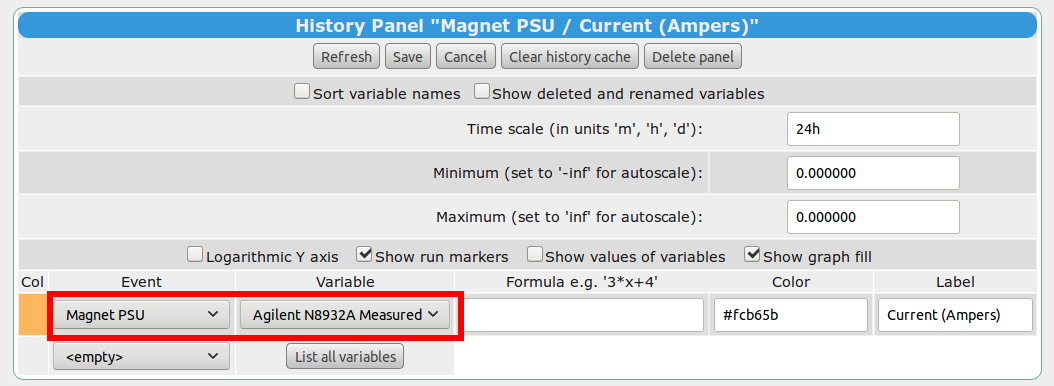
|
|
2104
|
25 Feb 2021 |
Konstantin Olchanski | Bug Report | Unexpected end-of-file |
> > [mhttpd,ERROR] [history.cxx:97:xread,ERROR] Error: Unexpected end-of-file when
> > reading file "/home/wagasci-ana/Data/online/210219.hst"
I am puzzled. We can try two things:
a) look inside the "bad" hst file, maybe we can see something. run "mhdump -L
/home/wagasci-ana/Data/online/210219.hst". If there is anything wrong with the file, it
will be probably at the end. You can also try to run it without "-L".
b) switch from "midas" history (.hst files) to "FILE" history (mh*.dat files), the
"FILE" history code is newer and the file format is more robust, with luck it may
survive whatever trouble is happening in your experiment. This is controlled in ODB
/Logger/History/XXX/Active (set to "y/n").
c) the output of "mlogger -v" may give us some clue, it usually complains if something
is not right with definitions of history data.
K.O. |
|
2098
|
25 Feb 2021 |
Isaac Labrie Boulay | Bug Report | Undefined client causing issues in transition. |
Hi all,
I'm currently experiencing an issue during run transitions. It comes in the form
of an alert saying "TypeError: Cannot read property 'length' of undefined"
whenever I'm in the "transition" window on mhttpd. I have attached an image of
what the transition window looks like when this happens.
By the looks of it and by peering at the lines in transition.html where the
error occurs, it's pretty obvious that there is some strange undefined client
that the web page tries to access.
I don't know how to find what this client is. Is there a way to see it in the
ODB?
The issues happens in show_client() of transition.html (called by callback()).
Here's the trace:
Uncaught (in promise) TypeError: Cannot read property 'length' of undefined
at show_client (?cmd=Transition:227)
at callback (?cmd=Transition:420)
at ?cmd=Transition:430
Any help would be very appreciated!
Thanks so much.
Isaac |
| Attachment 1: error_message.PNG
|
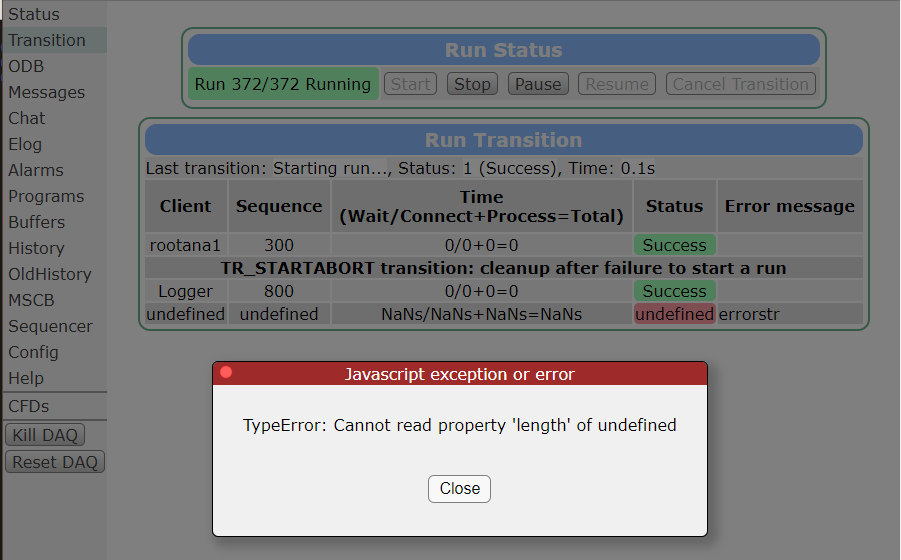
|
| Attachment 2: undefined_client.PNG
|
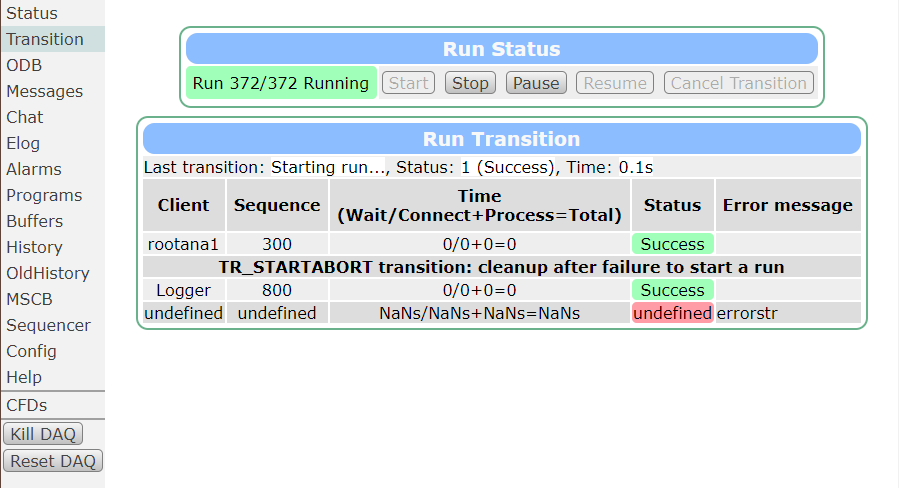
|
|
2103
|
25 Feb 2021 |
Konstantin Olchanski | Bug Report | Undefined client causing issues in transition. |
Clearly something goes wrong with the STARTABORT transition. Actually from your
sceenshot, it is not clear why the STARTABORT transition was initiated.
Usually it is called after some client fails the "start run" transition to inform
other clients that the run did not start after all. (mlogger uses this to close the
output file, etc).
But in the screenshot, we do not see any client fail the transition (only rootana1
was called, and it returned "green").
So, a puzzle. One possibility is that the transition code gets so confused
that it does not record correct transition data to ODB, then the web page
gets even more confused.
One way to see what happens, is to run the odbedit command "start now -v".
Can you try that? And attach all it's output here?
K.O. |
|
2109
|
26 Feb 2021 |
Isaac Labrie Boulay | Bug Report | Undefined client causing issues in transition. |
> Clearly something goes wrong with the STARTABORT transition. Actually from your
> sceenshot, it is not clear why the STARTABORT transition was initiated.
>
> Usually it is called after some client fails the "start run" transition to inform
> other clients that the run did not start after all. (mlogger uses this to close the
> output file, etc).
>
> But in the screenshot, we do not see any client fail the transition (only rootana1
> was called, and it returned "green").
>
> So, a puzzle. One possibility is that the transition code gets so confused
> that it does not record correct transition data to ODB, then the web page
> gets even more confused.
>
> One way to see what happens, is to run the odbedit command "start now -v".
>
> Can you try that? And attach all its output here?
>
> K.O.
Thanks for getting back to me right away. I've attached two screenshots. The first one
is the output after running "start now -v" (everything seemed to work nicely there), the
second output is after using odbedit to stop the run with "stop". Notice that the DAQ
never stops because it gets stuck in between transitions (You can see the run status
being "stopping run" with the cancel transition button).
Thanks.
Isaac |
| Attachment 1: start_now_-v_(1).PNG
|
.PNG.png)
|
| Attachment 2: stop.PNG
|
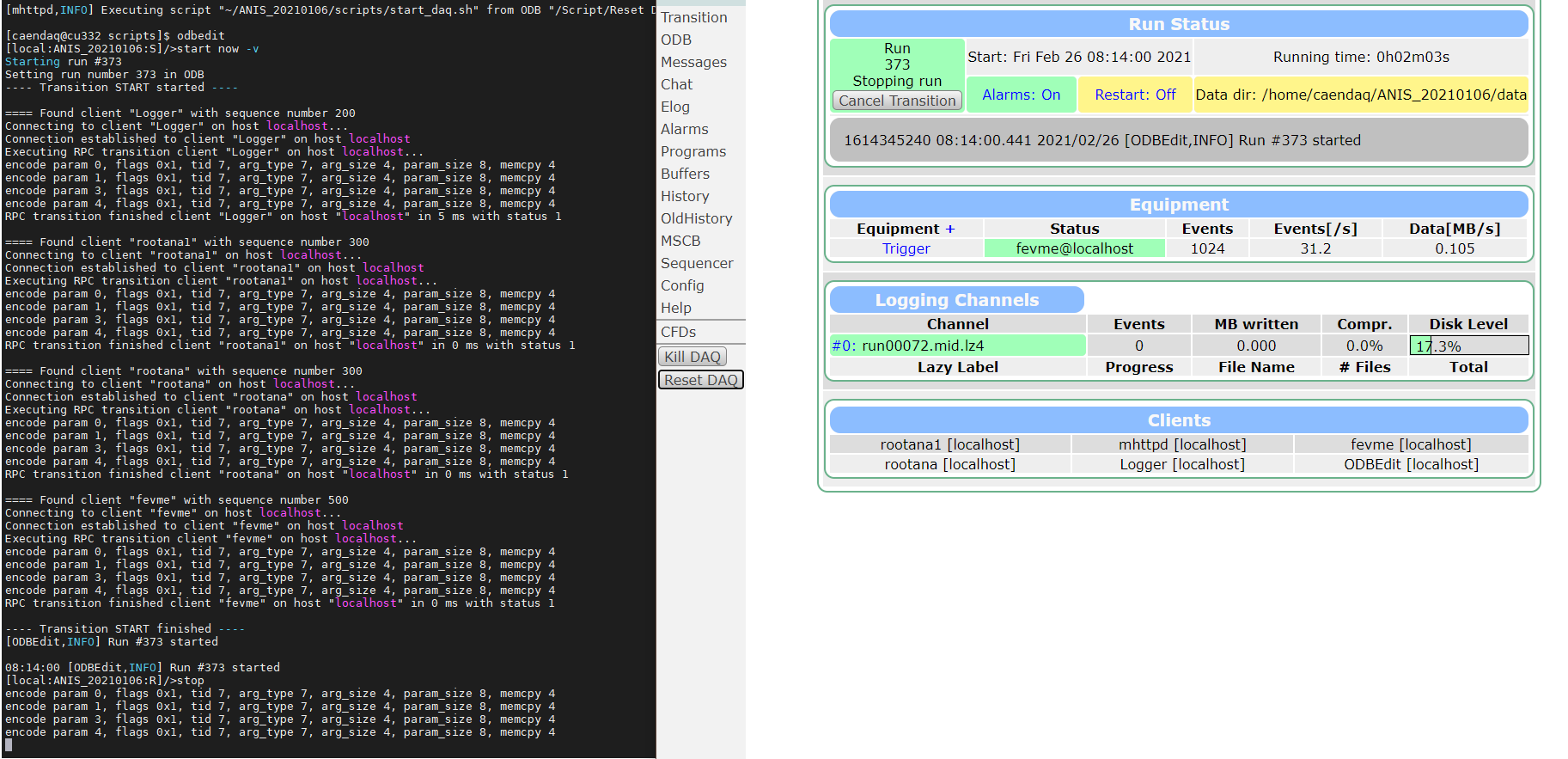
|
|
2111
|
26 Feb 2021 |
Konstantin Olchanski | Bug Report | Undefined client causing issues in transition. |
So there is no error on run start anymore? To debug the stuck run stop, please use "stop -v"
to see where it got stuck. You can also play with the RPC timeouts (the connect timeout and
the response timeout), to make it get "unstuck" quicker. Definitely it should not be stuck
forever, it should timeout at maximum of "rpc timeout * number of clients". K.O. |
|
2113
|
26 Feb 2021 |
Isaac Labrie Boulay | Bug Report | Undefined client causing issues in transition. |
> So there is no error on run start anymore? To debug the stuck run stop, please use "stop -v"
> to see where it got stuck. You can also play with the RPC timeouts (the connect timeout and
> the response timeout), to make it get "unstuck" quicker. Definitely it should not be stuck
> forever, it should timeout at maximum of "rpc timeout * number of clients". K.O.
You're right it does not stay stuck forever, it eventually gets unstuck. I forgot to mention this.
I will try to play with these timeout parameters. It does not get stuck if I run my DAQ using the
odbedit commands (start/stop). I don't know if this is relevant information that could help us
identify the problem.
Thanks for all your help as always!
Isaac |
|
2119
|
03 Mar 2021 |
Konstantin Olchanski | Bug Report | Undefined client causing issues in transition. |
> It does not get stuck if I run my DAQ using the odbedit commands (start/stop).
Interesting. Run start/stop from odbedit works but from mhttpd gets stuck.
I think they do not run the transition quite the same way. mhttpd uses the multithreaded transition.
So we can debug this using the "mtransition" program. Try:
- mtransition -v -d 1 START/STOP -- this should be same as odbedit
- mtransition -m -v -d 1 START/STOP -- this should be same as mhttpd
The "-v" and "-d 1" flags should cause lots of output, for failed transitions,
cut-and-paste it all into this elog here, should give us plenty of meat to debug.
K.O. |
|
270
|
11 Jul 2006 |
Razvan Stefan Gornea | Forum | Tundra Universe CA91C042 |
I am not using Midas but I need some help from somebody experienced with VME access using the Tundra Universe, so I thought here I have a chance ...
I have a GE Fanuc 7700 and use the vme_universe driver (ver. 3.3). In the past I programed for a DAQ board using A24/D16. Now I have a new board using A24/MB and I am really last!
So the board has some 64-bit registers and some 32-bit registers (all aligned on 64-bit) and a FIFO to read the main data. After reading the user manual for universe chip and the docs for the driver I am still confused about how things are supposed to work.
First my understanding is that for reading 64-bit I need anyway the multiplex block mode. But nowhere I could find if the multiplex mode supports 32-bit transfers. Should I map two windows on the same VME address range, one for A24/D32 and one for A24/MB? Or read everything with an unsigned long long and cast to unsigned int all 32-bit registers?
Second I don't know how to handle the FIFO which is in the middle of the address range. When the board has a trigger I have to read more than 100000 times this FIFO. If I simply read at the FIFO address 100000 times do I get the VME multiplex block mode (if the window has been mapped with A24/MB address modifier)? How does the chip/driver know not to send the address and just do the data cycle after the first read?
I also had the naive idea to have a master window mapped on the board address range to access all the registers except the FIFO and to create a DMA buffer for the FIFO (FIFO readout is where most of the work is anyway so I guess an advantage is that will free the CPU) but it seems to me that the dma_transfer function in the kernel module increments the address. I don't dare change this since I don't even understand the exact relationship between accesses to the mapped window and what's happening on the VME bus.
Thanks for any help! |
|
2376
|
29 Mar 2022 |
Hunter Lowe | Forum | Triggering without LAM signal - mcstd_libgpmc_camac driver |
Hello,
I have a question for anyone experienced with simple CAMAC systems.
My understanding is that for a single ADC system you can use a gate to generate a
LAM signal for triggering on ADC.
The driver that I have "mcstd_libgpmc_camac" has LAM "not implemented" though,
so I'm not sure how I should trigger DAQ. The frontend code that I have seems to use a TDC
as trigger for ADC via "EQ_POLLED" type equipment setting. Should I simply plug in TDC in my
system and use this as trigger? Is it as simple as TDC generates signal via gate and ADC performs job?
Sorry if question is super basic, just confused how to trigger without LAM signal.
Thank you :)
Hunter Lowe
UNBC Grad Physics |
|
1990
|
02 Sep 2020 |
Ruslan Podviianiuk | Forum | Transition status message |
Hello,
I got an error after start of run and it would be good to show this error (or
errors) in UI that I am developing. I see this error in the Transition
directory (please see the attached file). Is it possible to read the status
message and error messages from the Transition directory using jsonrpc? If yes,
could you please explain me how to do this.
Thank you.
Ruslan |
| Attachment 1: issue.png
|
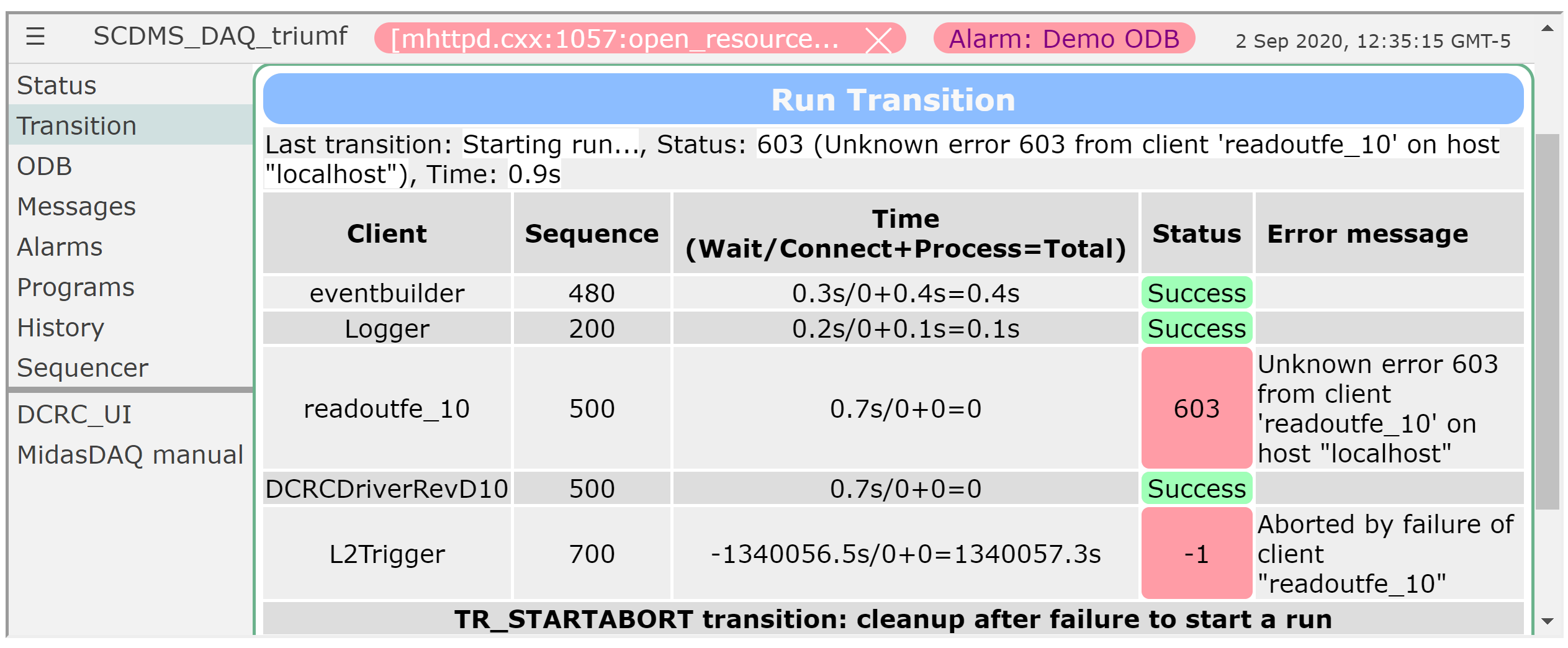
|
|
1991
|
02 Sep 2020 |
Ben Smith | Forum | Transition status message |
The information you want is in the ODB:
* "/System/Transition/status" is the overall integer status code.
* "/System/Transition/error" is the overall error message string.
There is also per-client status information in the ODB:
* "/System/Transition/Clients/<client_name>/status"
* "/System/Transition/Clients/<client_name>/error" |
|
1992
|
02 Sep 2020 |
Ruslan Podviianiuk | Forum | Transition status message |
> The information you want is in the ODB:
> * "/System/Transition/status" is the overall integer status code.
> * "/System/Transition/error" is the overall error message string.
>
> There is also per-client status information in the ODB:
> * "/System/Transition/Clients/<client_name>/status"
> * "/System/Transition/Clients/<client_name>/error"
Thank you so much, Ben! |
|
1995
|
08 Sep 2020 |
Konstantin Olchanski | Forum | Transition status message |
> > The information you want is in the ODB:
> > * "/System/Transition/status" is the overall integer status code.
> > * "/System/Transition/error" is the overall error message string.
> >
> > There is also per-client status information in the ODB:
> > * "/System/Transition/Clients/<client_name>/status"
> > * "/System/Transition/Clients/<client_name>/error"
You can also use web page .../resources/transition.html as an example of how
to read transition (and other) data from ODB into your own web page. example.html
may also be helpful.
K.O. |